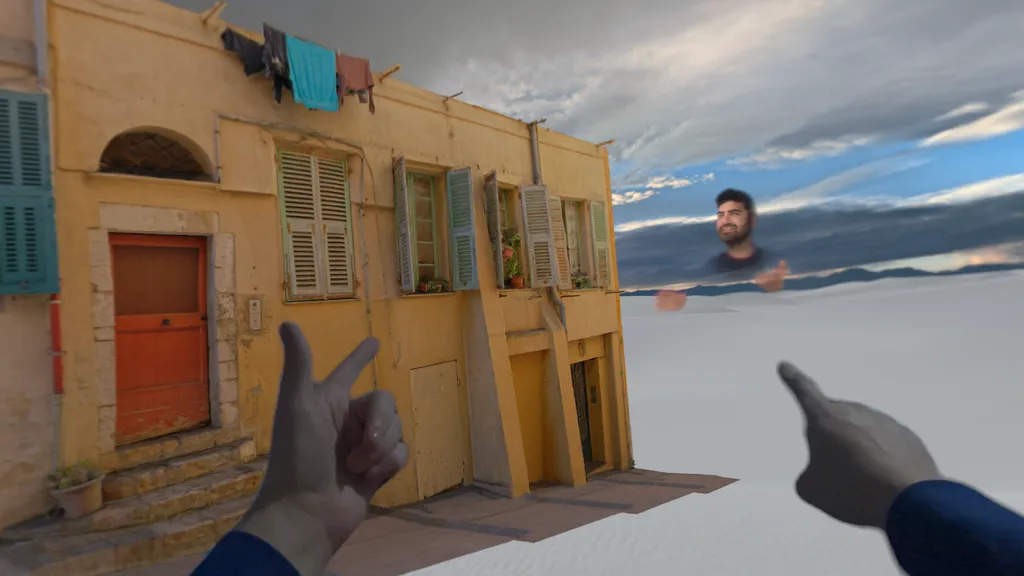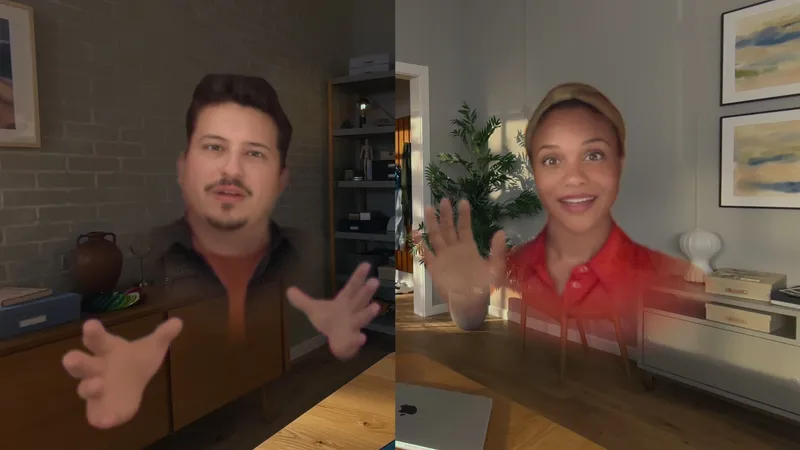Apple's Spatial Personas immediately change what it means to connect with someone else through virtual reality.
James O'Loughlin and I high fived within seconds of sharing a space together for the first time. We opened Apple's Freeform whiteboarding app and started putting together a list of movies we want to watch in VR. Though we'd connected previously over FaceTime, this was the first time I actually felt like we were sharing the same space in VR.
FaceTime calls still start as flat avatars in a window, but if you press the Spatial Personas button they'll emerge from the window like General Zod and his friends popping out of the Phantom Zone.

We started testing Apple's SharePlay service across different windows, testing each for whether its content is blocked by a digital rights management layer. YouTube content, for example, could be viewed together in sync either through the Juno app or as a website in Safari. This only works for videos that have been posted publicly without that DRM layer, so you won't be watching protected content made in Hollywood with another person unless you both have an active subscription to the same SharePlay-enabled app, like Disney+.
Apple's own subscription services like Apple Arcade and Apple TV+ are the most obvious candidates for using Spatial Personas together. Game Room from Resolution Games, for example, is on Apple Arcade and offers classic titles like chess for people to enjoy gathered around a table together. David Heaney and developer Mike Manzano connected on a call with me and we set up a game of chess in my office. Even though Meta had board games on its headsets years ago, being able to look across the table and see the expressions on your opponent's face as you move your piece is something I haven't truly been able to experience in VR until this. The avatars might not match human realism in appearance – you always know you're looking at a digital human – but they are good enough. My first impressions were wrong and I didn't become uncomfortable after a few minutes, bringing me the closest I've felt to VR successfully collapsing space between people.
While Apple's content subscription services are geared toward general consumers, the $3,500 Vision Pro is firmly in the category of professional computing device. We've encountered multiple Vision Pro buyers who purchased the headset but opted not to continue free trials for Apple's subscriptions. This means not only will Vision Pro owners have trouble finding someone else with the headset to SharePlay with as Spatial Personas, but even if they have the headset there's a chance you won't be able to access some of the best content without one of these subscriptions.
The flip side, of course, is that Spatial Personas just gave those people a major reason to pony up a little more and subscribe to those services in order to unlock a large large number of SharePlay-enabled movies, TV shows, and games they can experience in the same room with telepresent participants.

Around 1 pm Eastern I started receiving calls from my Vision Pro-owning contacts on the west coast of the United States. I was in a different headset broadcasting the VR Download at the time, but after I finished I connected with Azad Balabanian. He, like the others I connected with, immediately marveled at the freedom to really move around one another as soon as he emerged from the phantom zone. He opened up a 3D model of a scene he had captured, and we hovered together in front of a large door. We could both move the model, and we could point out tiny details with our hands and immediately follow the finger to its intended target. The lighting in our physical rooms seemed to cast different shadows across the model for each of us, with him seeing the model cast in bright morning light streaming through his physical window, and myself seeing it lit by my overhead bulb.
We also watched a few minutes of Edge of Tomorrow in 3D from Apple TV+. I've watched my share of movies in Bigscreen and those experiences do not match how closely this resembled sitting on the couch and watching something together. I could tell he was reclined on his own couch, for instance, based on the way he was sitting, and we could glance at one another for a bit of conversation during the movie and make what felt like real eye contact as we did so. We each controlled the volume and captions for ourselves.
Meta has been working on its own hyper-realistic avatars system for years now that could one day provide a similar sense of powerful social presence with another physically distant person. In fact, after demos at Meta in 2022, I suggested the idea might be VR's killer app.
Apple Vision Pro launched in February without its killer app. You still can't connect with many people this way just yet and, at $3,500, very few people can afford to right now. Still, I had four VR developers in my home yesterday for engaging conversations and activities together and I've never been able to do that before in a VR headset.
Telepresence

"Telepresence" is an idea many people are familiar with, but its meaning would seem to have been watered down by decades of substandard video calling. Take, for instance, Cisco's "telepresence" systems, depicted above, and Google's Starline effort. Each would attempt to solve the same problem – letting people see eye-to-eye from two physically distant rooms through means other than putting on a VR headset. There's a reason this technology only exists inside board rooms at very large companies. It is stupid expensive, and very boring, to have two rooms set aside just so you can look directly into the whites of the eyes of your colleagues and plan future layoffs. How would Google or Cisco ever hope to put those systems in front of everyone on the planet? They wouldn't, with prices so high they're not even posted online publicly.
Meta might not be able to get its Codec Avatar technology running on a $500 or even a $1000 or $1500 headset just yet. Apple, however, was able to get Personas into a $3,500 system two months after release. And while much of UploadVR's audience doesn't have the ability to check this out right now, there's going to be some executives and venture capitalists reading this and re-considering whether Spatial Personas was what was missing during the push to work from home during the pandemic.
Ethics Disclosure: Ian is married to an Apple employee.
























